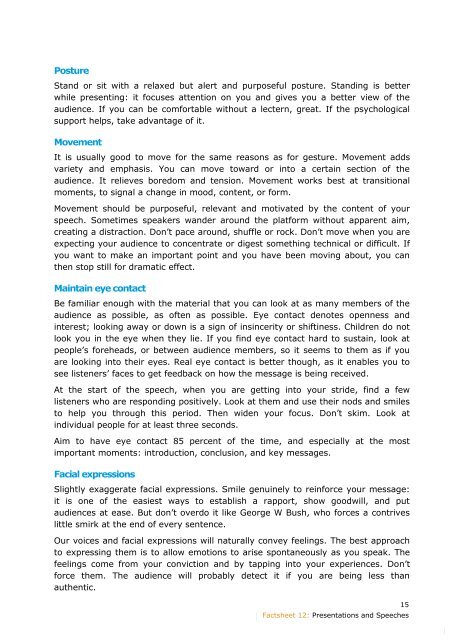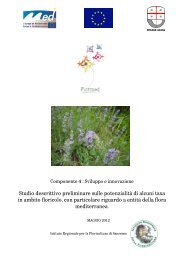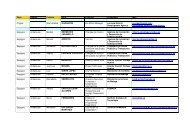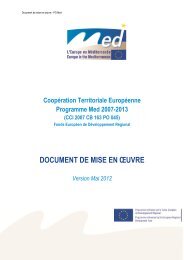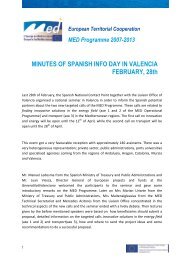MED Communication Handbook - Programme Med
MED Communication Handbook - Programme Med
MED Communication Handbook - Programme Med
Create successful ePaper yourself
Turn your PDF publications into a flip-book with our unique Google optimized e-Paper software.
Posture<br />
Stand or sit with a relaxed but alert and purposeful posture. Standing is better<br />
while presenting: it focuses attention on you and gives you a better view of the<br />
audience. If you can be comfortable without a lectern, great. If the psychological<br />
support helps, take advantage of it.<br />
Movement<br />
It is usually good to move for the same reasons as for gesture. Movement adds<br />
variety and emphasis. You can move toward or into a certain section of the<br />
audience. It relieves boredom and tension. Movement works best at transitional<br />
moments, to signal a change in mood, content, or form.<br />
Movement should be purposeful, relevant and motivated by the content of your<br />
speech. Sometimes speakers wander around the platform without apparent aim,<br />
creating a distraction. Don’t pace around, shuffle or rock. Don’t move when you are<br />
expecting your audience to concentrate or digest something technical or difficult. If<br />
you want to make an important point and you have been moving about, you can<br />
then stop still for dramatic effect.<br />
Maintain eye contact<br />
Be familiar enough with the material that you can look at as many members of the<br />
audience as possible, as often as possible. Eye contact denotes openness and<br />
interest; looking away or down is a sign of insincerity or shiftiness. Children do not<br />
look you in the eye when they lie. If you find eye contact hard to sustain, look at<br />
people’s foreheads, or between audience members, so it seems to them as if you<br />
are looking into their eyes. Real eye contact is better though, as it enables you to<br />
see listeners’ faces to get feedback on how the message is being received.<br />
At the start of the speech, when you are getting into your stride, find a few<br />
listeners who are responding positively. Look at them and use their nods and smiles<br />
to help you through this period. Then widen your focus. Don’t skim. Look at<br />
individual people for at least three seconds.<br />
Aim to have eye contact 85 percent of the time, and especially at the most<br />
important moments: introduction, conclusion, and key messages.<br />
Facial expressions<br />
Slightly exaggerate facial expressions. Smile genuinely to reinforce your message:<br />
it is one of the easiest ways to establish a rapport, show goodwill, and put<br />
audiences at ease. But don’t overdo it like George W Bush, who forces a contrives<br />
little smirk at the end of every sentence.<br />
Our voices and facial expressions will naturally convey feelings. The best approach<br />
to expressing them is to allow emotions to arise spontaneously as you speak. The<br />
feelings come from your conviction and by tapping into your experiences. Don’t<br />
force them. The audience will probably detect it if you are being less than<br />
authentic.<br />
15<br />
� Factsheet 12: Presentations and Speeches<br />
�


